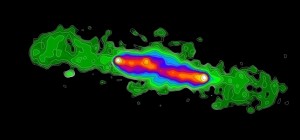Since his Ph.D. thesis on the growth of radio jets 40 years ago, Paul Wiita, chair of The College of New Jersey’s Physics Department, has been fascinated with radio galaxies, the largest connected objects in the universe. His most recent work on them, in collaboration with Dr. S. Sirothia and Prof. Gopal-Krishna of Pune, India, concerns the discovery of “fossil lobes”on the well-known radio galaxy “3C452,” and is soon to be published in the March 1, 2013 issue of Astrophysical Journal Letters. Through research launched twenty years before by Wiita and Gopal-Krishna, and the use of software developed by Sirothia, the three scientists have changed the classification of 3C452 from a “classical” to “double-double” radio galaxy, and, consequently, unearthed a clue to the evolution of our universe.

A radio galaxy, such as 3C452, normally has two extensive lobes filled with extremely hot gas (plasma) and magnetic fields that can extend far beyond the stars that make up the visible galaxy. These lobes are inflated by plasma moving at nearly the speed of light through a pair of jets. The oppositely directed jets are launched from the vicinity of an extremely massive black hole at the center of the galaxy. By rapidly orbiting the lines of magnetic field, the plasma’s electrons create electromagnetic radiation seen as radio waves through a radio telescope. During their approximately 10 million years of activation, these “radio-loud” lobes can grow millions of light years long, pushing through intergalactic gasses and filling created voids with plasma. “The energy and momentum carried by the jets that form the lobes can compress clouds of much colder gas. This can trigger star formation,” said Wiita. “If the clouds are massive enough, then the formation of entire galaxies could be triggered by the radio lobes.”
The production of stars and galaxies by radio lobes has led to the theory that radio galaxies played a role in the evolution of the universe, a theory that has become more The Giant Metrewave Radio Telescope (GMRT) of Gopal, India, used to observe the fossil lobes of Galaxy 3C452strongly supported with the discovery of Double-double radio galaxies (DDRGs). DDRGs are radio galaxies with four lobes of plasma instead of two. The outer lobes are called “fossil lobes,” as they are relics of past activity of the radio galaxy, indicating that there were at least one previous active period. Through the same mechanisms seen in today’s radio lobes, fossil lobes may have contributed to the synthesis of past stars and galaxies, advancing the evolution of the universe.
Through observations taken at the low radio-frequency of 325 megahertz with the Giant Metrewave Radio Telescope (GMRT) in India, Sirothia, Gopal-Krishna, and Wiita discovered fossil radio lobes around 3C452, signifying that this galaxy also was emitting radio waves in the past and the lobes may have contributed to the evolution of the universe.

Their work illustrates that lower radio frequency observations may lead to more DDRG discoveries that would strengthen the theory that radio galaxies significantly contributed to the universe in the past. With the construction of more sensitive telescopes in Australia and Europe, the 3C452 discovery may be the forerunner of many more DDRG discoveries to come.
